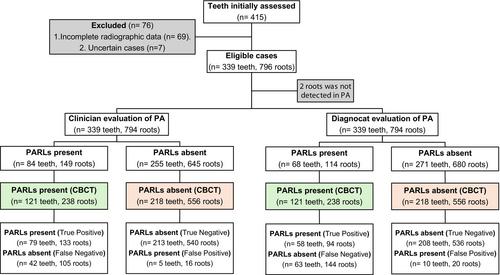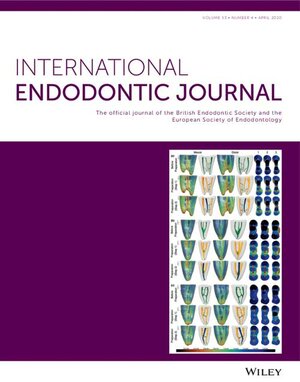The detection of apical radiolucencies in periapical radiographs: A comparison between an artificial intelligence platform and expert endodontists with CBCT serving as the diagnostic benchmark
Abstract
Aim
Accurate detection of periapical radiolucent lesions (PARLs) is crucial for endodontic diagnosis. While cone beam computed tomography (CBCT) is considered the radiographic gold standard for detecting PARLs in non-root filled teeth, its use is often limited by cost and radiation exposure. Artificial Intelligence (AI)-based radiographic analysis has shown the potential to enhance the diagnostic capability of periapical (PA) radiographs, but its accuracy, compared with CBCT, needs further evaluation.
The aim of this paper is to assess the diagnostic accuracy of Diagnocat, a commercial AI-driven platform in detecting PARLs on PA radiographs of teeth diagnosed with irreversible pulpitis or pulp necrosis and scheduled for primary root canal treatment, using CBCT as the reference standard, and to compare Diagnocat's performance with that of experienced clinicians.
Methodology
This retrospective diagnostic accuracy study analysed 339 teeth (796 roots). PA radiographs were independently assessed by two experienced, calibrated endodontists and by Diagnocat. CBCT scans, serving as the reference standard, were evaluated by two different endodontists, blinded to the PA radiograph results. Sensitivity, specificity, accuracy and area under the receiver-operating characteristic curve (AUC-ROC) were calculated for Diagnocat and clinicians at both tooth and root levels.
Results
CBCT identified PARLs in 121 (35.7%) teeth and 240 (30.2%) roots. Diagnocat displayed a high level of correlation with clinicians in determining lesion status, with an agreement of 89%. Clinicians demonstrated significantly higher accuracy at the tooth level (86.1% vs. 78.5%, p < .001) and greater sensitivity (65.3% vs. 47.9%, p < .001) than Diagnocat, while specificity was comparable (97.7% vs. 95.4%, p = .3). Similar trends were observed at the root level. AUC-ROC values were higher for clinicians than Diagnocat at both tooth (0.81 vs. 0.72) and root (0.77 vs. 0.68) levels, although these differences were not statistically significant.
Conclusion
While Diagnocat exhibited high agreement with clinicians in detecting PARLs on PA radiographs, clinicians demonstrated superior accuracy and sensitivity overall. Notably, Diagnocat performed comparably to experienced clinicians in cases without PARLs, highlighting its potential utility for reliably ruling out disease. However, further refinement is required before it can reliably complement clinical judgment in endodontic practice.


 求助内容:
求助内容: 应助结果提醒方式:
应助结果提醒方式:


